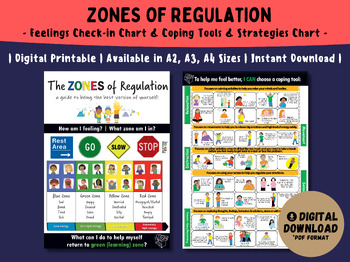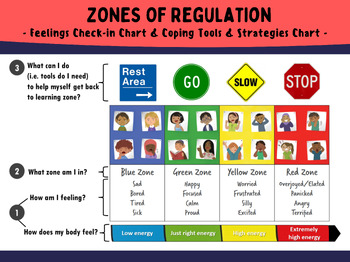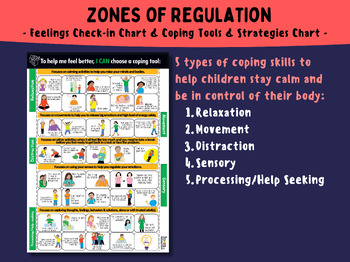Zones of Regulation Feelings Check-in Poster
Description
"Zones of Regulation Feelings Check-in and Coping Skills Poster" is a set of two posters designed to help with emotional regulation, recognizing and managing emotions effectively. They are ideal for classrooms, counselor's offices, or even at home. The A2, A3, and A4 sizes provide flexibility to fit different spaces.
1. Zones of Regulation Feeling Check-in Chart:
How it helps: This poster provides a visual representation of different emotional states or "zones". It is great for helping children identify their emotional state throughout the day. By categorizing emotions into zones (typically depicted by colors), children can learn to identify if they're feeling calm (green zone), happy and alert (blue zone), frustrated (yellow zone), or overwhelmed (red zone). By recognizing their zone, they can choose appropriate response - rest, go ahead, slow down, stop.
- Body Cues: It prompts children to consider physical signs like energy levels (low, just right, high, extremely high) which can indicate emotional state.
- Emotions List: For each zone (blue, green, yellow, red), there's a list of corresponding feelings (e.g., calm, happy, frustrated, angry). This helps connect physical sensations with emotions.
- Identifying Your Zone: By considering body cues and emotions, individuals can identify their current zone (calm, learning, fight or flight).
- Regulation Strategies: "What can I do to help myself get back to learning zone?" prompts children to consider tools or strategies they can use to regulate their emotions and return to a focused state.
2. Coping Tools / Strategies Chart:
How it helps: This poster provides a reference for various coping tools / skills (i.e. strategies for managing emotions). When a child finds themselves in a yellow or red zone, they can refer to this chart and choose a coping strategy that best suits their needs. This empowers them to take charge of their emotions and find ways to calm down and return to a more regulated state.
- Types of Coping Skills: It breaks down coping skills into five categories: relaxation (deep breathing), movement (jumping jacks), distraction (doodling), sensory (chewing gum), and processing/help-seeking (talking to a friend).
- Examples for Each Type: Each category includes specific examples of coping mechanisms that fall under that type. This provides individuals with a range of options to try depending on the situation and their preferences.
By having these posters displayed, children can easily refer to them to understand their emotions, identify their zone, and choose appropriate coping mechanisms to regulate their emotions and return to a calmer, more focused state.
This can be helpful tools for parents, teachers, and caregivers to support children in social-emotional learning. By providing a visual framework for understanding emotions and self-regulation strategies, these charts can empower children to manage their emotional well-being.
*Additional notes:
- The A2, A3, and A4 sizes allow for flexibility in how you use these charts. You can print them in a smaller size for individual student use or a larger size for classroom display.
- Consider laminating the charts for durability and reusability.




